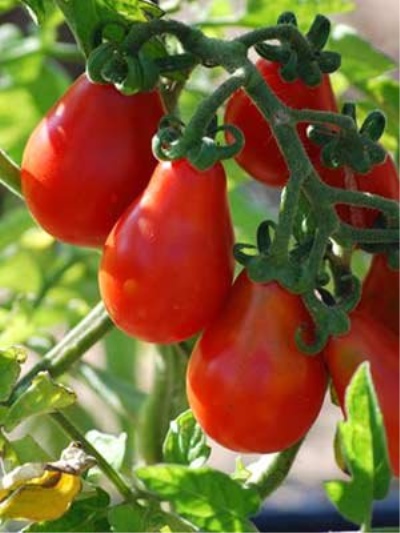
- Authors: Vasilevsky V. A., Nalizhity V. M., Korotkov S. A., Kochkin A. V. (JSC Scientific and Production Corporation "NK. LTD")
- Year of approval: 2000
- Category: grade
- Growth type: indeterminate
- Appointment: universal
- Ripening period: mid-season
- Ripening time, days: 110-115
- Growing conditions: for open ground, for film greenhouses, for greenhouses
- Transportability: good
- Bush size: tall
Tomato Red pear can become the real king of the garden. You just need to get to know him more thoroughly and study the main points deeper. And you should start with the origin of this culture.
Breeding history
The plant was officially approved for use in 2000. Its development was carried out in the "Scientific and Production Corporation NK LTD". The direct selection work was carried out by specialists:
Vasilevsky;
Kochkin;
Filled;
Korotkov.
Description of the variety
Red pear is an indeterminate universal tomato. It can be grown in open ground. And also cultivation in closed with a film and in ordinary greenhouses is allowed. The bushes can grow up to 1.8-2 m. Medium-sized green leaves are typical of tomatoes in general.
The main qualities of the fruit
Like many other varieties, Red Pear is initially green in color and is distinguished by a dark green spot in the area of the stalk. Ripe berries will surely turn red. The mass of a single specimen is 45-65 g. There are 5 to 9 tomatoes per brush.
A characteristic feature of the tomato shape is that it looks like a pear. That is why there is a corresponding name. The skin of the fruit will be smooth. It develops from a simple inflorescence. The stalk has an articulation, and the berries themselves are lightweight and suitable for transportation.
Taste characteristics
This culture is characterized by a classic rich taste. The harvest will delight everyone who loves ordinary tomatoes. The main use is fresh consumption or self-canning. It is less suitable for extracting juice and making a paste, but it can also be used.
Ripening and fruiting
This is a simple mid-season variety. On average, it will take from 110 to 115 days to wait for the berries to appear. The countdown comes when small green shoots come to the surface.
Yield
The collection can be from 5 to 5.6 kg per 1 sq. m. Compared to other varieties, this tomato is not so bad.
The timing of planting seedlings and planting in the ground
The earliest date for sowing in containers is at the end of February. Some farmers plant seeds there in early March. Transfer to greenhouses is carried out in late April or early May. But transplanting into the ground is possible at least in May. In regions with relatively cold climates, it is better to wait until June. Specific dates are determined individually, according to the actual weather.

Growing tomato seedlings is an extremely important process, because it largely depends on whether the gardener can harvest at all. All aspects must be taken into account, from seedbed preparation to planting in the ground.
Landing scheme
There is no need to invent anything original. It is recommended to follow the 40x60 cm system. It is necessary to form the bushes into 1 or 2 stems.

Growing and care
The red pear will have to be tied up. It will also not be possible to do without pinning and shaping. For growing seedlings, it is recommended to use a soil mixture. It is advised to keep the seedling boxes under cling film.
The time for landing in the ground comes only after the soil warms up to 15 degrees. Passionking is carried out 1 time in 6-8 days. In addition to mineral fertilizers and organics, ash can be used. The greenhouse will have to be regularly and actively ventilated. Therefore, this variety is not for those who are used to looking at the dacha only from time to time.




A plant needs different micronutrients at each stage of growth. All fertilizers can be divided into two groups: mineral and organic. Folk remedies are often used: iodine, yeast, bird droppings, eggshells.
It is important to observe the rate and period of feeding. This also applies to folk remedies and organic fertilizers.


Resistant to adverse weather conditions
Red pear is stress-resistant. This means that it is fairly well protected from both extreme heat and relatively cold weather. But the winners will be those gardeners who do not abuse this property. Basic support measures (greenhouses, active watering) are very helpful.
Growing regions
Cultivation of Red Pear is possible:
in Western Siberia;
in Eastern Siberia;
in the vicinity of Moscow;
in the Leningrad region;
in Karelia, Novgorod, Arkhangelsk regions;
in the Primorsky Territory, Jewish Autonomous Region and other regions of the Far East;
in the territories and republics of the North Caucasus;
in the Volga and Chernozem regions.
Review overview
The ripening of tomatoes at the same time makes summer residents very happy. They just need to be collected and processed.Care is quite simple, and watering is required no more than once every 2-3 days. The planting seeds are small, and their sachet will last for a long time. Most often, Red Pear is used for home canning.
It is often grown in a greenhouse. The variety is not too susceptible to tomato diseases. Even if an infection occurs, the problem is easily solved by treatment with special drugs. Compliance with simple care measures, according to reviews, gives an excellent result. Of particular importance is the regularity of fertilizing and fertilization.

























































































